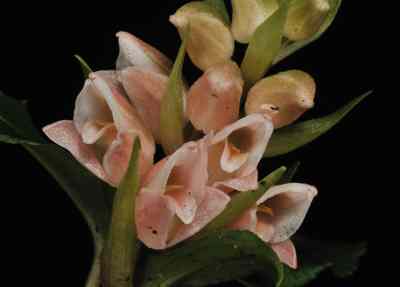The Plant
Terrestrial. A small of the height between 7 to 10 cm. Stem cylindrical, fleshy, decumbent at the base. Leaves green, 4 to 7, lanceolate, petioled with a narrow sheath, three nerved bordered with white, with the mid one wider than the other two, margins of the leaf undulate as well as minutely serulate to its apex. Flower many, arranged closely in a short peduncle.
The Flower
Flower 1 cm across. Sepals unequal, ovate, acute, connate at the base; dorsal smaller than the lateral, diagonally erect and connivent with the petals; lateral diagonally spreading with its apex curved behind and margins curved. Petals rhombic, smaller than the petals. Lip oblong with broad base, long, decurved, channeled at its middle. Column and rostellum long. Floral bracts long, diminishing in length to its apex, lanceolate, erect.
Sepals and petals pale rose flushed with white. Petals more to the whitish base. Lip pale rose turning whitish rose to its apex. Column bright yellow. Floral bracts pale green flushed with pale brown at its base.

The Pursuit
I found this species when they were at an early stage of growth, from deep inside a forested area in the semi alpine zone during a routine survey. There were more than 200 plants of this species in a small area under thick forest cover. The entire forest was covered with huge tall trees, but the forest floor was relatively open without any undergrowth. Hence, I was able to count the plants, but gave up when the count reached 200. From close observation it was clear it would take another 30 to 45 days for them to be in flower. But, I made it a point to visit the location once in a week. During my second visit in two weeks, my assistant found one plant fully grown and with buds around 15 m from the main cluster. The buds were about to open and we decided to make a visit in the next five days. The scheduled 5th day was washed out due to rains and on the next day I was forced to trek to the location all alone. While I was approaching those small plants, I was surprised to notice several ripped tree leaves spread all over the forest floor. My curiosity to locate a species in bloom made me walk ahead. As I was sitting next to the plant and noting down its characteristics I felt some movement over my shoulders. I got really scared and while looking back I found one white-chested bear (Ursus thibetanus) sitting on top of a tree behind me. That was the first time I had spotted a white-chested bear from that region. The bear seemed so scared it was clinging to the tree. As a rule, I immediately packed up my camera bag and moved out of that area without disturbing the bear.
After that, I made six more visits to that location to document the species. During each visit I hoped I would crisscross the bear again but it never reappeared again.
Reference:
King, G. &Pantling, R. (1898). The Orchids of the Sikkim-Himalayas. Ann. Roy. Bot. Garden. (Calcutta). Goodyera foliosa Benth. ex Hook., Page no 281 – 282.